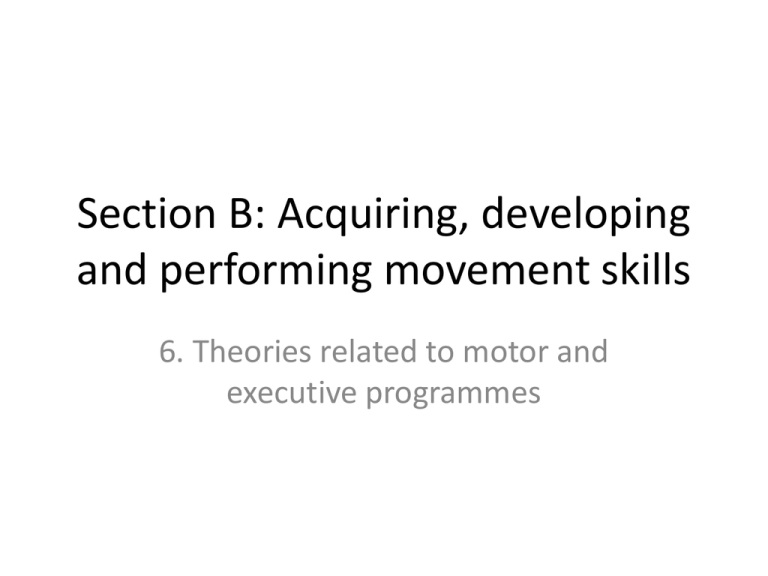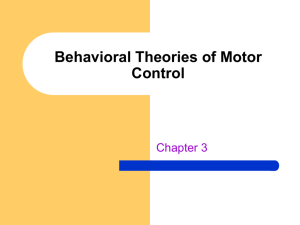6. Theories related to motor and executive programmes
advertisement

Section B: Acquiring, developing and performing movement skills 6. Theories related to motor and executive programmes Syllabus • Definition as a generalised series of movements: creation of programmes in the long term memory • Open loop control • Closed loop control • Schema theory Motor programmes and control of movement • A generalised series or pattern of movements stored in the long term memory • Every skill performed in sport is the result of a motor programme. • Motor programmes are hierarchical – there is an order of importance with the executive motor programme being of the highest status. • Motor programmes are also sequential – they are performed in a particular order. • Motor programmes are made up of sub-routines performed in a particular order • As the performer becomes more skilled, the existing executive motor programme is relegated and superseded by a new programme • Traditional view of a motor programme was that it was a centrally organised, pre-planned set of very specific muscle commands which, when initiated, allowed the entire sequence of movement to be carried out, without reference to additional feedback • Executive motor programme – A sequence of linked movements which are stored in the long term memory and retrieved when required – Helps to explain how performers sometimes appear to be able to carry out very fast actions that have been well learned (closed skills) without really thinking about the action – This has obvious links to Fitts and Posner’s autonomous stages of learning • Each executive motor programme has a series of subroutines which have to be performed in the correct order if the skill is to be completed effective Tennis serve Ball toss Back swing Forward swing Contact Follow through Javelin Grip Run-up Cross-over steps Throwing action Recovery • In relating this notion of automatic movement to information processing, you can appreciate that the limited capacities of the memory process would easily be overloaded, and would take considerable time if every part of every action had to pass via the short-term memory • The notion of a motor programme being decided on and initiated from the short-term memory appears to solve the overload problem, where, in relatively stable situations, movement can be carried out without the need for modification • This type of control of movement is called openloop control, without feedback Open-loop control • Pre-learned mastered movements initiated on command, are thought to be developed through practice • These complete movements or motor programmes can be stored in the long-term memory and retrieved at will A simplified model of open-loop control INPUT EXECUTIVE MOVEMENT CONTROL CENTRE MOVEMENT (COMMANDS AND INSTRUCTIONS) EFFECTOR SYSTEM MOVEMENT OUTPUT • This process usually occurs during the completion in a closed skill (for example, skipping or running), but can also take place in an open skill such as catching a ball • Transfer of information is done through a ‘memory trace’ • Skills produced via open loop are performed without conscious thought and are often ballistic e.g. A throw or kick • There is no feedback as there is no time to act upon any information about performance • Movement cannot be changed once it has started e.g. Once a golf swing has been initiated the action cannot be modified Expanded model of open-loop INPUT (Information processing stages where motor programme is determined) STIMULUS IDENTIFICATION RESPONSE SELECTION RESPONSE PROGRAMMING MOTOR PROGRAMME (effector systems stage) STM RECEIVES MOTOR PROGRAMME FROM LTM & STM INITIATES VIA THE EFFECTOR SYSTEMS SPINAL CORD MUSCLES MOVEMENT ENVIROMENT Closed-loop control • Closed loop involves feedback • Level two operates through a short feedback loop which passes through the muscle spindles • This is termed the ‘perceptual trace’ • The feedback loop is short • Internal feedback is gained through kinaesthesis and proprioception during the performance of the skill • This allows fast, sub-conscious corrections to be made • Adjustments are then stored in the long term memory for future reference e.g. A skier will constantly adjust position to retain balance Closed-loop control • The brain controls and modifies movement by passing corrective messages back to the muscles • The loop involves conscious thought and attention to external feedback • Often used at the associative stage of learning- reliance on external feedback is needed because the learner has not yet acquired the correct feel of the skill • Performance is jerky and ill-timed • The perceptual trace compares performance as it is taking place with the plan released by the memory trace • If the performance matches the plan the skill is reinforced and allowed to continue • If the performance does not match the plan the skill is adjusted and this change is stored as a new motor programme e.g. Changing direction to avoid an opponent when dribbling in hockey – requires conscious thought Expanded model of closed-loop Practical performance often involves both open and closed loop • Most sporting activities involve a variety of coordinated movements • Performers continually move between open and closed loop control • Memory trace is used for selecting and initiating movement – it does not control movement • Perceptual trace is used to compare movements with previous experiences, making adjustments when needed • E.g. A trampolinist will initiate a series of movements using the memory trace. During the sequence the feedback gained through kinaesthesis and proprioception allows them to adjust the movements based on previous experience. If they are losing height during the routine this will affect the timing of subsequent movements, they can try to correct this by gaining additional height on the next bounce Criticisms of the motor programmes theory • It assumes that a separate motor programme or plan is needed for each skill or movement – it would not be possible to store an infinite number of programmes. • Even if it were possible to store an infinite number of motor programmes it would be difficult for the memory trace to retrieve the plan in time to execute the skill. • It also suggests that practice should be accurate and that variance would hinder learning • In sport responses are often creative and apparently spontaneous, called ‘novel responses’. If the relevant motor programme does not exist in the memory the novel response cannot be explained. Schema theory • States that motor programmes are not stored as separate items but as relationships • These relationships are termed ‘generalised movements’ • Schema is a build up of experiences which can be adapted to meet the demands of the new situation • We learn and control movements by developing generalised patterns of movement around certain types of movement experience (e.g. catching and throwing) • E.g. An experienced badminton player will have developed a motor programme for the smash shot, but will not have a programme for performing this from all areas of the court. However, the player will have many different experiences to draw on. These are schemas which are stored in the long term memory which can be transferred to a new situation. Schemas are used to modify the programme of the smash shot so that it can be played from a variety of positions. • Schema theory states that information is gathered from recall schema and recognition schema A schema for throwing can be adapted • Returning a cricket ball to the keeper • A long pass in basketball • Throwing a javelin By collating as much movement information as possible with regard to throwing, we can adapt to new situations because we know the general rules associated with throwing long, short, high, low and so on. • Variety of practice is essential Recall schema • Knowledge of initial conditions – whether a performer has previously experienced a similar situation • E.g. In rugby an attacker in possession of the ball approaches a defender • Knowledge of response specifications – knowing what to do in this situation • E.g. What are the options? Pass, dummy, dodge or kick Recognition schema • Knowledge of sensory consequences – knowing how the skill should feel, involves kinaesthesis • E.g. Attacker needs to know how hard to pass the ball in order to reach the target • Knowledge of movement outcome – involves knowing what the outcome of the movement is likely to be • E.g. A dummy would send the defender in the wrong direction KNOWLEDGE OF ENVIRONMENT POSITION OF BODY POSITION OF LIMBS SPECIFIC DEMANDS OF THE SITUTATION DIRECTION SPEED FORCE 1) SENSORY CONSEQUENCES (WHAT MOVEMENT FEELS LIKE) INFORMATION BASED ON SENSORY FEEDBACK DURING AND AFTER MOVEMENT INVOLVES ALL SENSORY SYSTEMS 1) RESPONSE OUTCOMES COMPARISONS ARE MADE BETWEEN ACTUAL OUTCOME AND INTENDED OUTCOME KR IS IMPORTANT 1) INITIAL CONDITIONS (WHERE RECALL SCHEMAS (INFORMATION IS WE ARE) STORED ABOUT DETERMINING AND PRODUCING THE DESIRED MOVEMENT) 1) RESPONSE SPECIFICATION (WHAT WE HAVE TO DO) RECOGNITION SCHEMAS (INFORMATION IS STROED ENABLING EVALUATION OF MOVEMENT) (WHAT HAS HAPPENED) Strategies/methods to enable schema to develop • Varied practice conditions – practice relevant to the game (e.g. opposition) • Include plenty of feedback – tasks should be challenging







